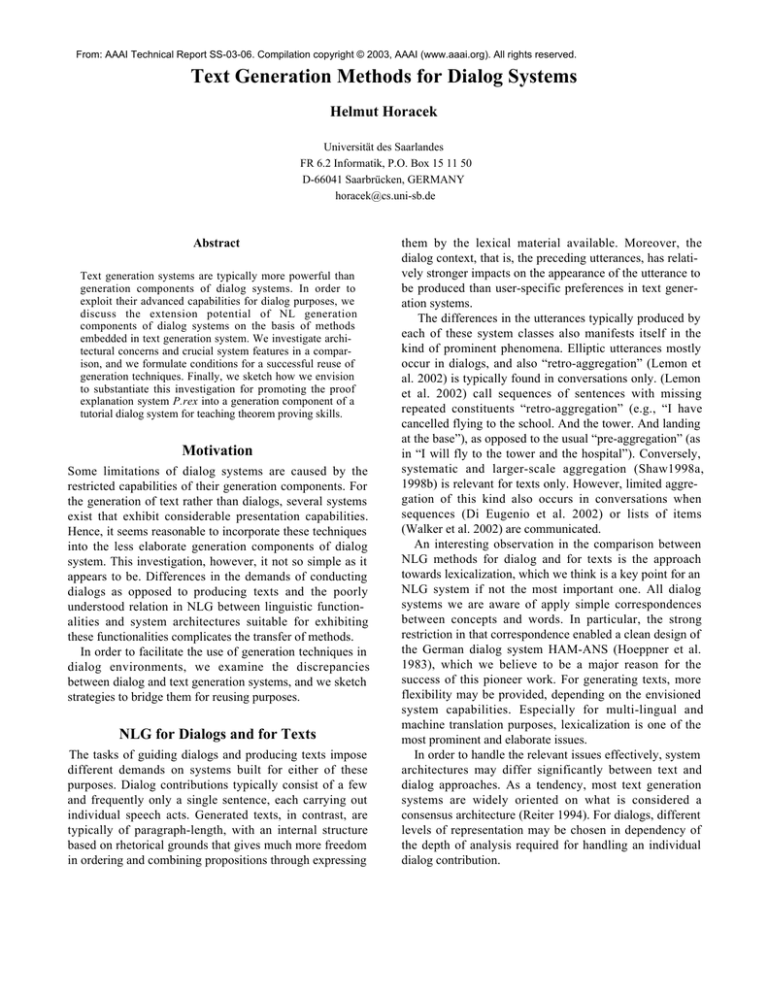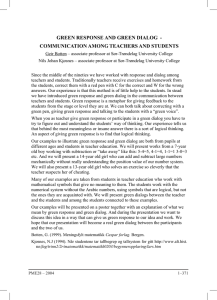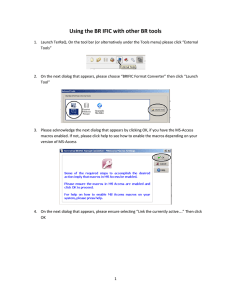
From: AAAI Technical Report SS-03-06. Compilation copyright © 2003, AAAI (www.aaai.org). All rights reserved.
Text Generation Methods for Dialog Systems
Helmut Horacek
Universität des Saarlandes
FR 6.2 Informatik, P.O. Box 15 11 50
D-66041 Saarbrücken, GERMANY
horacek@cs.uni-sb.de
Abstract
Text generation systems are typically more powerful than
generation components of dialog systems. In order to
exploit their advanced capabilities for dialog purposes, we
discuss the extension potential of NL generation
components of dialog systems on the basis of methods
embedded in text generation system. We investigate architectural concerns and crucial system features in a comparison, and we formulate conditions for a successful reuse of
generation techniques. Finally, we sketch how we envision
to substantiate this investigation for promoting the proof
explanation system P.rex into a generation component of a
tutorial dialog system for teaching theorem proving skills.
Motivation
Some limitations of dialog systems are caused by the
restricted capabilities of their generation components. For
the generation of text rather than dialogs, several systems
exist that exhibit considerable presentation capabilities.
Hence, it seems reasonable to incorporate these techniques
into the less elaborate generation components of dialog
system. This investigation, however, it not so simple as it
appears to be. Differences in the demands of conducting
dialogs as opposed to producing texts and the poorly
understood relation in NLG between linguistic functionalities and system architectures suitable for exhibiting
these functionalities complicates the transfer of methods.
In order to facilitate the use of generation techniques in
dialog environments, we examine the discrepancies
between dialog and text generation systems, and we sketch
strategies to bridge them for reusing purposes.
NLG for Dialogs and for Texts
The tasks of guiding dialogs and producing texts impose
different demands on systems built for either of these
purposes. Dialog contributions typically consist of a few
and frequently only a single sentence, each carrying out
individual speech acts. Generated texts, in contrast, are
typically of paragraph-length, with an internal structure
based on rhetorical grounds that gives much more freedom
in ordering and combining propositions through expressing
them by the lexical material available. Moreover, the
dialog context, that is, the preceding utterances, has relatively stronger impacts on the appearance of the utterance to
be produced than user-specific preferences in text generation systems.
The differences in the utterances typically produced by
each of these system classes also manifests itself in the
kind of prominent phenomena. Elliptic utterances mostly
occur in dialogs, and also “retro-aggregation” (Lemon et
al. 2002) is typically found in conversations only. (Lemon
et al. 2002) call sequences of sentences with missing
repeated constituents “retro-aggregation” (e.g., “I have
cancelled flying to the school. And the tower. And landing
at the base”), as opposed to the usual “pre-aggregation” (as
in “I will fly to the tower and the hospital”). Conversely,
systematic and larger-scale aggregation (Shaw1998a,
1998b) is relevant for texts only. However, limited aggregation of this kind also occurs in conversations when
sequences (Di Eugenio et al. 2002) or lists of items
(Walker et al. 2002) are communicated.
An interesting observation in the comparison between
NLG methods for dialog and for texts is the approach
towards lexicalization, which we think is a key point for an
NLG system if not the most important one. All dialog
systems we are aware of apply simple correspondences
between concepts and words. In particular, the strong
restriction in that correspondence enabled a clean design of
the German dialog system HAM-ANS (Hoeppner et al.
1983), which we believe to be a major reason for the
success of this pioneer work. For generating texts, more
flexibility may be provided, depending on the envisioned
system capabilities. Especially for multi-lingual and
machine translation purposes, lexicalization is one of the
most prominent and elaborate issues.
In order to handle the relevant issues effectively, system
architectures may differ significantly between text and
dialog approaches. As a tendency, most text generation
systems are widely oriented on what is considered a
consensus architecture (Reiter 1994). For dialogs, different
levels of representation may be chosen in dependency of
the depth of analysis required for handling an individual
dialog contribution.
Dialog systems
Typical requirements
Typical functionalities
Typical architecture
Text generation systems
Short utterances
Context and speechact-driven
Ellipsis, retro-aggregation
Simple concept-lexeme mapping
Simplified representations
Flexible processing
Longer text passages
Organization through text planning
Systematic aggregation
Flexible concept-lexeme mapping
Stratified representation levels
Uniform processing
Table 1. Comparison between generation components of dialog systems and text generation systems
The considerations about contrastive features of text generation systems and generation components of dialog
systems are summarized in Table 1.
Consequences for Building Systems
Given the discrepancies as outlined in the previous section,
we believe that extending the functionality of generation
components, notably those of dialog systems, requires
particular foresight. In order to adopt techniques from text
generation systems purposefully, we are convinced that the
following fundamental condition must be met: An architecture needs to be chosen which is considered appropriate
for handling all aspects of the functionality ultimately
envisioned. To a large extent, this architecture may be
inspired by an appropriate existing text generation system.
In contrast, we believe that incremental extensions are
problematic, since there is little agreement on the order of
subtasks in the generation process, which is oriented on the
specific functionality of implemented systems (Cahill et
al. 1999). In particular, this holds for the approach chosen
towards lexicalization; incrementally extending its coverage would mean augmenting the repertoire of recasting
operations in mapping conceptual specifications onto lexical items – this has strong impacts on all other subprocces.
In addition, adopting an architecture of a text generation
system for dialog purposes requires some modifications:
(1) Specifications must be processed in partitions,
separately for each of the speech acts to be produced,
(2) Preceding dialog contributions must be structurally
incorporated in the system's context representation.
(3) Processing certain kinds of speech acts should be
handled as architectural short-cuts.
The latter aspect tends to favor the exploitation of preceding dialog contributions in reference and ellipsis generation
rather than avoiding repetitions.
An Example – Our Future Project
In the near future, we intend to adopt this strategy for
making use of the system PROVERB (Huang and Fiedler
1997) and its successor P.rex (Fiedler 2001), in order to
build a dialog system that is able to guide tutorial dialogs
in teaching mathematical theorem proving. In this task,
exchanging short and typical dialog contributions are interleaved with occasional, longer descriptions of proof
techniques. This setting seems to be ideal for combining
techniques from dialog systems and text generation.
In its current state, P.rex is able to produce paragraphlength explanations of machine-found mathematical
proofs. Thereby, it varies degrees of detail and explicitness
in its presentations, in dependency of user specifications.
The system is a typical applied text generation system
following the "consensus" architecture in a stratified way.
It has a text planner that reorganizes and linearizes a
rhetorically inadequate textplan, which is the presentationoriented perspective on the proof graph, that is the
representation of the machine-found proof. Its sentence
planner includes a rule-based subsystem for performing
aggregation operations, a lexicalization module with
paraphrasing capabilities, mostly synonyms and variations
in word categories (e.g., "associative", and "associativity")
and a reference generation mechanism based on focus
spaces in Grosz' and Sidner's style. All these components,
while being general in their architecture, are tailored to the
domain of mathematics and to the presentation demands of
theorem proving to a certain extent.
When promoting P.rex into a dialog system, all its
present features will be maintained, since the exposition of
a full proof may still be required, although this will not
frequently be the case. Most of the time, the system will
have to produce confirmations, rejections, or corrections,
investigate clarification subdialogs, and most importantly,
provide hints. For all these kinds of utterances, neither the
present representations of domain concepts provide
sufficient information nor do the capabilities of the text
generation module give support. Therefore, extensions are
not only required in terms of domain representations and
associated uses (e.g., what a hint is, and the domain
concepts, which the system should be able to hint at), but
also in terms of proper generation capabilities.
In order to pursue these issues in a systematic manner,
the first thing to be settled is the lexicalization mechanism.
Our application is ambitious through its high degree of
variations (ranging from simple utterances, such as confirmations or denials to elaborate explanations), but it does
not require a detailed command of natural language
subtleties, as this would be the case in an application
related to machine translation. Therefore, we confine
ourselves with the existing approach to lexicalization as
adopted by P.rex., by which compositionality is guaranteed
so that this subprocess easily fits into a standard pipe-line
architecture. If it will later turn out that some cases require
alternative conceptualizations, we intend to handle this
when building the specifications for the utterance or as a
restructuring operation within the text planning process,
depending on the kind of alternation required.
In addition to this architectural decision, meeting the
new demands requires several extensions to P.rex,
addressing dialog-relevant properties. These concern
(1) A generalization of the focus mechanism of P.rex; at
present, this mechanism is only able to build a structure for a system's monolog. In the future, it must
overarch several utterances of both conversants.
(2) The repertoire of speech acts, which currently consists
of domain-specific communicative acts about mathematical concepts, is augmented to cover hints, confirmations, denials, etc. Obviously, this also comprises
expansions of the domain models and the vocabulary.
(3) A model for producing elliptic answers, especially in
clarification dialogs needs to be developed and integrated into the system in an economic way.
Some potentially useful extensions may not prove relevant
to our application, for instance expanding the aggregation
operators to handle “retro-aggregation”. If it will turn out
that this feature is needed, this means that a new set of operators is to be built and used alternatively to the existing
one, depending on whether the specifications cover an
elaborate explanation or a sequence or similar speech acts.
Finally, the overall organization of the generation procedure is modified. Instead of processing all the material in
one pass, which is beneficial for producing elaborate
explanations in an adequate form, a partitioning is imposed
on the basis of the sequence of speech acts to be produced.
Depending on the kind of speech act, one or several
subphases may be skipped, thereby introducing processing
short-cuts. In particular, we intend to use this techniqe for
handling ellipsis.
Conclusion
In this paper, we have discussed the extension potential of
NL generation components of dialog systems on the basis
of methods embedded in text generation system. We have
addressed the problems imposed by this investigation,
including architectural concerns and crucial system
features, and we have sketched our future plans for the
proof explanation system P.rex. We believe that this issue
will also be relevant for future systems in the typical dialog
applications travel and restaurant information, when pure
information-seeking is enhanced by advisory capabilities.
References
Cahill, L.; Doran, C.; Evans, R.; Mellish, C.; Paiva, D.;
Reape, M.; Scott, D., and Tipper. N. 1999. In Search of a
Reference Architecture for NLG Systems. In Proceedings
of the 7th European Workshop on Natural Language
Generation, 77-85.
Di Eugenio, B.; Glass, M.; and Trolio. M. 2002. The
DIAG Experiments: Natural Language Generation for
Intelligent Tutoring Systems. In Proc. of the 2nd International National Language Generation Conference, 120-127.
Fiedler. A. 2001. Dialog-Driven Adaptation of Explanations of Proofs. In Proc. of the 17th IJCAI, 1295-1300.
Hoeppner, W.; Christaller, T.; Marburger, H.; Morik, K.;
Nebel, B.; and O'Leary, M. 1983. Beyond Domain-Independence: Experience with the Development of a German
Language Access System to Highly Diversible Background Systems. In Proc. of the 8th IJCAI-83, 588-594.
Huang, X.; and Fiedler. A. 1997. Proof Verbalization as an
Application of NLG. In Proc. of the 15th IJCAI, 965-970.
Reiter, E. 1994. Has a Consensus NLG Architecture
Appreared and is it Psychologically Plausible?. In Proc. of
7th International Workshop on Natural Language Generation, 163-170.
Lemon, O.; Gruenstein, A.; Battle, A.; and Peters, S. 2002.
Multi-Tasking and Collaborative Activities in Dialogue
Systems. In Proceedings of the 3rd SIGDial Workshop on
Discourse and Dialogue, 113-124.
Shaw. J. 1998a. Segregatory Coordination and Ellipsis in
Text Generation. In Proceedings of the 36th Association
for Computational Linguistics and the 17th International
Conference on Computational Linguistics, 1220-1226.
Shaw. J. 1998b. Clause Aggregation Using Linguistic
Knowledge. In Proc. of the 9th International Workshop on
Natural Language Generation, 138-147.
Walker, M.; Whittaker, S.; Stent, A.; Maloor, P.; Moore,
J.; Johnston, M.; and Vasireddy. G. 2002. Speech-Plans:
Generating Evaluative Responses in Spoken Dialogue. In
Proc. of the 2nd International National Language Generation Conference, 73-80.





